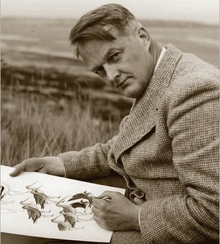Roger Tory Peterson
| Roger Tory Peterson | |
|---|---|
 |
|
| Born |
August 28, 1908 Jamestown, New York |
| Died | July 28, 1996 (aged 87) Old Lyme, Connecticut |
| Occupation | author, ornithologist, naturalist |
| Nationality | American |
| Subject | Birds |
| Notable works | Wild America, The Peterson Field Guides |
Roger Tory Peterson (August 28, 1908 – July 28, 1996) was an American naturalist, ornithologist, artist, and educator, and held to be one of the founding inspirations for the 20th-century environmental movement.
Peterson was born in Jamestown, New York, August 28, 1908. His father, Charles Peterson, was an immigrant from Sweden, coming to America as an infant. At the age of ten, C. Peterson lost his father to appendicitis, and he was sent off to work in the mills. After leaving the mills, he earned his living as a traveling salesman. His mother, Henrietta Badar, was an immigrant from Germany, at the age of four, growing up in Rochester, New York. She went to a teachers' college, and was teaching in Elmira, New York, when she met Charles. They married, and moved to Jamestown, a small, industrial city in south-west New York, where C. Peterson took a job at a local furniture factory.
Peterson's first work on birds was an article "Notes from field and study" in the magazine Bird-lore, where he recorded anecdotally two sight records from 1925, a Carolina wren and a titmouse.
In 1934 he published his seminal Guide to the Birds, the first modern field guide, which sold out its first printing of 2‚000 copies in one week, and subsequently went through 6 editions. One of the inspirations for his field guide was the diagram of ducks that Ernest Thompson Seton made in Two Little Savages (1903). He co-wrote Wild America with James Fisher, and edited or wrote many of the volumes in the Peterson Field Guide series, on topics ranging from rocks and minerals to beetles to reptiles. He developed the Peterson Identification System, and is known for the clarity of both his illustrations of field guides and his delineation of relevant field marks.
...
Wikipedia
